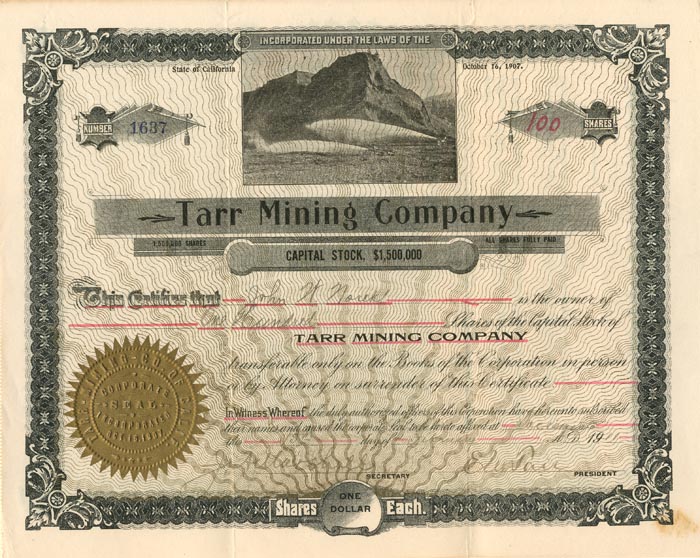Tarr Mining Co. - Stock Certificate
Inv# MS2033 Stock
Stock. Unique hydraulic vignette photo!
In 1848, when James W. Marshall discovered gold at Sutter's Mill in Coloma (some 50 mi or 80.5 km northeast of the fort), numerous gold-seekers came to the area, increasing the population. In August 1848, Sutter Sr.'s son, John Sutter Jr., arrived to assist his father in reducing his indebtedness. The Sutters struggled to contain the effects of thousands of new gold miners and prospectors in the area, many who squatted on unwatched portions of the vast Sutter lands, or stole various unattended Sutter properties or belongings if they could. For Sutter, his employee's discovery of gold in the area turned out to be more of a personal "bane" for him.
By December 1848, John Sutter Jr., in association with Sam Brannan, began laying out the City of Sacramento, 2 miles (3.2 km) south of his father's settlement of New Helvetia. This venture was undertaken against the wishes of Sutter Sr., but the father, being deeply in debt, was in no position to stop the venture. For commercial reasons, the new city was named "Sacramento City" after the Sacramento River. Sutter Jr. and Brannon had United States Army Captain William H. Warner assigned to draft the official layout of the city, which included 26 lettered and 31 numbered streets (today's grid from C St. to Broadway and from Front St. to Alhambra Blvd.) Relations between Sutter and his son became embittered after Sacramento became an overnight commercial success. (Sutter's Fort, Mill, and the town of Sutterville, all founded by John Sutter Sr., eventually failed).
Residents of Sacramento adopted a city charter in 1849, which was recognized by the state legislature in 1850. Sacramento is the oldest incorporated city in California, incorporated on February 27, 1850.
During the early 1850s, the Sacramento valley was devastated by floods, fires and cholera epidemics. Despite this, the new city's location just downstream from the Mother Lode in the Sierra Nevada proved irresistible, and it grew rapidly, attracting a population of 10,000.
The California State Legislature, with the support of Governor John Bigler, moved to Sacramento in 1854. The capital of California under Spanish (and, subsequently, Mexican) rule had been Monterey, where, in 1849, the first Constitutional Convention and state elections were held. The convention decided San Jose would be the new state's capital. After 1850, when California's statehood was ratified, the legislature met in San Jose until 1851, Vallejo in 1852, and Benicia in 1853, before moving to Sacramento. In the Sacramento Constitutional Convention of 1879, Sacramento was named as the permanent state capital.
The Classical Revival-style California State Capitol, similar to the national Capitol, was started in 1860 and completed in 1874. In 1861, the legislative session was moved to the Merchants Exchange Building in San Francisco for one session because of massive flooding in Sacramento. From 1862 to 1868, part of the Leland Stanford Mansion was used for the governor's offices during Stanford's tenure as the Governor; and the legislature met in the Sacramento County Courthouse. The legislative chambers were first occupied in 1869, while construction continued around them.
With its new status and strategic location, Sacramento quickly prospered. It was designated as the western terminus of the Pony Express. Later it became a terminus of the First Transcontinental Railroad, which began construction in Sacramento in 1863 and was financed by "The Big Four"—Mark Hopkins, Charles Crocker, Collis P. Huntington, and Leland Stanford. Both the American and especially Sacramento rivers were key elements in the economic success of the city. Sacramento effectively controlled commerce on these rivers, and public works projects were funded through taxes levied on goods unloaded from boats and loaded onto rail cars in the historic Sacramento Rail Yards.
In 1850 and again in 1861, Sacramento residents suffered a completely flooded town. In 1861, Governor Leland Stanford, who was inaugurated in early January 1861, traveled to his inauguration in a rowboat. The event was held not too far from his house in town on N Street. The flood waters were so bad, the legend says, that when Stanford returned to his house, he had to enter into it through the second floor window.
From 1862 until the mid-1870s, Sacramento raised the level of its downtown by building reinforced brick walls on its downtown streets, and filling the resulting street walls with dirt. The previous first floors of buildings became the basements, with open space between the street and the building, previously the sidewalk, now at the basement level. Over the years, many of these underground spaces have been filled or destroyed by subsequent development. However, it is still possible to view portions of the "Sacramento Underground".
During the 1850s the city was consolidated with the County of Sacramento.
A stock certificate is issued by businesses, usually companies. A stock is part of the permanent finance of a business. Normally, they are never repaid, and the investor can recover his/her money only by selling to another investor. Most stocks, or also called shares, earn dividends, at the business's discretion, depending on how well it has traded. A stockholder or shareholder is a part-owner of the business that issued the stock certificates.










Ebay ID: labarre_galleries